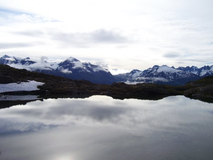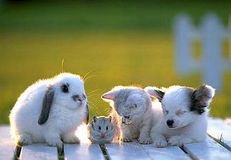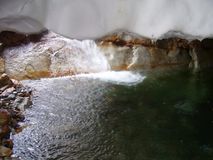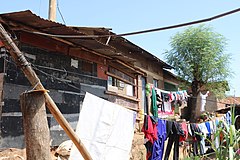DeAnza College/CIS2/Summer 2010/Group 7
Contents
- 1 What is environmental sustainability?
- 2 Target 1: Environmental law implementation and Environmental Resource Gain
- 3 Target 2: Gain Biodiversity by 2010
- 4 Target 3: Increase Access to Water and Sanitation by 50%
- 5 Target 4: Life Improvement of 100 million slum dwellers by 2020
- 6 Final Note
- 7 Contributor
- 8 Resources
- 9 Viewer Feedback
What is environmental sustainability?
The ability to elongate human survival to the maximum while using the least amount of Earth resources. With an increasing human population, everyone will need to find more and more ways of finding the proper resources because there is not guarantee that we will still have the same resources decades from now. This is the reason there is a rise in extravagant resources like solar, wind, and thermal power. In a sustainable it is not just about properly throwing trash in the appropriate bins, but using what is thrown away to help create something that can be used for a different purpose. Breakthroughs like the ones found by EPA scientist found that much of the air pollution has been present in the air for quite some time and is not merely caused by our car exhaust. At first, it was hard to accurately measure the amount of toxicicity in the air, but with the development of Community Multi-scale Air Quality system (CMAQ),for example, researchers are now able to predict air quality and better enable themselves to find ways to control pollution. Agencies such as the EPA, Environmental Protection Agency, work side by side with the federal and state government to make sure rules and regulations are past to ensure air quality. What does it mean to those who are not apart of government agencies or pro-environment organizations such as EPA? As everyday humans we have to play our roles in helping save our environment and we cannot merely rely on the studies and resources of those in powers. Everyone has to learn to empower themselves to not only better themselves, but also the environment because one day we may wake up to find something either gone or severely depleted. It is imperative not to ignore animals, as well as the environment, because we are all apart of a monstrous cycle that is never ending. If one or more species were to go extinct it would have a cataclysmic effect on the rest of world.There are four engineering research that serve as a means to help in the progress of environmental sustainability. The four are: industrial ecology, green engineering, ecological engineering, and earth systems engineering. Industrial ecology deals with a lot of "life cycle assessment, materials flow analysis, input/output economic models, and novel metrics for measuring sustainable" (National Science Foundation). In other words, industrial ecology tries to figure out what resources can be used up based upon life cycles of humans and animals, economic models, and measuring instruments such as the CMAQ. Green engineering encourages chemical and manufactoring processes, green buildings, and city infrastructure. Due to advancements in green engineering, a new method using water and wastewater treatments is starting to be perfected that will help mitigate energy and material usage. Ecological engineering focuses its attention to restoring ecological functions to natural systems(mother nature). Also, ecological engineering has brought about advancements in stream restoration, revitalizing urban rivers, and restoring wetlands to as close to what they were before human intervention. Earth systems engineering looks at reasons why, for example, greenhouse gas emissions and climate change(global warming) are so dangerous. Finding out what the side effects of greenhouse gas emission does to the earth and how it may or may not affect climate change is the one of the areas earth systems engineering specializes in.
Can anyone phathom life without any of our natural resources and environment? No, because we have not experienced it. No matter what religion and science may say or think, none can accurately calculate to 100% what life would be like without any of them let alone both. All the riches of the world would mean nothing becaue no one can buy natural resources as they are made from mother nature. Humans can only manipulate natural resources for their purposes and cannot physically produce them at the same level as mother nature. Preservation of our environment is intrumental to human and animals alike for survival. We have no other means of survival because Earth is the only planet currently able to provide enough resources for human and animals to survive. Yes, we are making progress in terms of finding some form of life on other planets, but it will take a long time before we are able to find legitamite evidence to prove we can survive on that planet. In the mean time, we will need to live with what we have and what mother nature gives us. "All humans do not understand natural resources. Most humans do not value natural resources! Yet we live only because we have the natural resources. Houston, we have a problem (What are Natural Resources)!"
Target 1: Environmental law implementation and Environmental Resource Gain
For the past 20 years or so, environmental resources have been slowly depleting. Threat of global warming and climate change have been widely discussed over the recent years due to deforestation, Co2 emission, and non-clean energy. The big question is how and when are we going to make the political/social change needed to ensure sustainability throughout the world. With the forest showing statistical signs of decrease and co2 emissions depleting the ozone, what can be done to halt, slow down, and or reverse the damages? Through clean renewable energy, there are several positive environmental impacts that can save trees and the ozone.
Studies show that in the 1990's, nearly 16million hectares of trees were being removed from the ground every year. However, over the last decade, an average of 3 million hectares of trees have been reduced from 16 million a year back in the 1990’s. The effort to slow down and protect trees has been noticed and throughout the regions of the world, people and organizations are repopulating trees to counteract the trees be harvested and destroyed by natural causes. A good rule of thumb that one could implement when cutting down trees would be, for one every tree taken out, plant two in its place (seeds). Due to the lack of population control, trees are having to be torn down to create houses, cities, corporations, etc. to provide sufficient living standards for people. Someday soon, perhaps within the next 20 years there will be a population control agreement signed across the world to avoid further over population. It is written in stone” Maintain humanity under 500,000,000 in perpetual balance with nature” … currently we are at about 7.6 Billion, on track for 8.5 Billion by 2025.
As of 2007, the calculated emissions of carbon dioxide reached 30 Billion metric tons. It was said that, because of the economic plummet starting in 2008, there would be a fall in global emissions. As we know, this is not a solution but a stalling period before the economy rises back up again only to put more gas in their cars and tear down the ozone. Consumers may not be at fault for this, for some of us we have to drive an hour to work every morning. Corporations are delaying change and milking the oil because of its massive profits. One success in reducing the disintegration of the ozone was through the Montreal Protocol. Because of this treaty, governments around the world are required to phase out all use of Ozone Depleting Substances. It is proven that throughout the last 20 years or so the global ODS (Ozone Depleting Substances) have been reduced by about 98%. This alone was perhaps the most important treaty that has been passed in the history man.
Our world is at the brink of technological singularity, we have enough information and technology to harness clean renewable energy worldwide without the use of fossil fuels and polluting-emissions. Currently there are 7 potential clean energy solutions; they are Bio fuel, Biomass, hydroelectricity/hydro-power, solar energy, tidal power, wind power, and last but least is geothermal energy. Bio fuel is made by fermenting sugar components of plant materials and is made mostly from sugar and starch crops. Bio Mass is a type of fuel made up of animal waste and plant materials. Hydroelectricity is a renewable energy source created obtained by using the natural down force of gravity on the flow of water with a machine. Solar energy is basically obtaining sun light through solar panels and converting into usable energy. Tidal power is a form of conducting energy from tidal shifts, tides, and waves in the ocean by installing turbines. In the UK they have spotted 42 sites that are available, statistics show that 34% of all UK’s power could derive from tidal power alone. Wind energy is important as well, if wind mills were fully harvested in just 3 states it could generate enough energy to power the entire nation. Geo-thermal energy is essentially the conversion of heat that is generated from the earth’s core, it is said that we must drill nearly 60 miles deep in the earth’s mantle to be able to tap sufficient heat energy. As you can see there is no shortage in ideas and solutions on how to merge into purely clean renewable energy without the use of damaging fossil fuels or other elements. Due to oil corporations around the world there will always be oil in the industry along with clean energy until we have used the last drop. Fortunately clean renewable energy is a hot topic and is being looked over for implementation around the world.
The world has come a long ways in the last 20 years. With technology being consistently improved and the current technology we have available today, we can prevent climate change (global warming/cooling), save our eco-system, and halt destruction of our ozone through Co2 emissions/other ODS and potentially repair it. No one nation or country can change the way the world runs, we must unite for the greater cause of preserving humanity, life, and mother earth.
Target 2: Gain Biodiversity by 2010
In June 2001, the heads of the EU announced their intention to halt biodiversity loss by 2010. The following year the UN took up the challenge to “achieve by 2010 a significant reduction of the current rate of biodiversity loss”. However, the world has missed the deadline of reducing biodiversity loss by 2010 leading to serious consequences. Despite increased investments and efforts being made to reduce biodiversity loss, the loss of species are expected to continue throughout the century. Biodiversity is threatened by high rates of consumption, habitat loss, invasive species, pollution, and climate change.
The shrinking of the biodiversity has a huge impact on the lives of human beings. Biodiversity provides the necessity that makes life possible. It provides fresh water, clean air, and nutrients and without them, it is impossible for humans to survive. Billions of people, including many of the poorest, rely directly on diverse species of plants and animals for their very survival. “Nearly 17,000 species of plants and animals are known to be threatened with extinction” (MDG, 2010). Studies show that this loss will continue causing an “increasing risk of dramatic shifts in ecosystems and erosion of benefits for society”. The reduction in biodiversity loss will also hamper efforts to meet other MDGs, especially those related to poverty, hunger and health, by increasing the vulnerability of the poor and reducing their options for development.
Although efforts are being made to protect the planet's land and sea area, it is important to ensure that all areas are being covered instead of just focusing on a few. Studies show that in 2009, "only half of the world’s 821 terrestrial eco-regions—large areas with characteristic combinations of habitats, species, soils and landforms—had more than 10 per cent of their area protected" (MDG, 2010). This is in conflict with the Convention on Biological Diversity, where it states that one tenth of the areas of all these eco-regions should have been under protection by 2010. Progress is being made to rectify this issue, but not at a fast enough pace. However it is important to note that, “while certain areas may be officially ‘protected’, this does not mean that they are adequately managed or that the coverage provided is sufficient to effectively conserve critical habitats and species” (MDG, 2010).
Technology can definitely play a huge role in helping the United Nations to gain biodiversity as it can repair the damage being done by our use of non-renewable energy. New technologies are emerging everyday and are finding ways to harness renewable energy, and growing food more efficiently. The internet has also heightened environmental awareness , and the importance of maintaining biodiversity. In addition, Plant science technologies, including crop protection and plant biotechnology are also helping farmers increase the productivity of existing arable land in use, significantly reducing the need to expand agricultural land, and therefore limiting the loss of biodiversity and natural habitats.
Target 3: Increase Access to Water and Sanitation by 50%
By 2015, the goal is to amplify sustainable access to safe drinking water and basic sanitation by 50%. These are things which every human being should have a right to and every person who can, should constantly be striving to make this a reality. At this point, drinking water seems attainable but the part about sanitation may be out of reach by 2015. So far Eastern Asia has improved the most regarding drinking water “where access to drinking water improved by almost 30 per cent over the period 1990-2008” (MDG Report 2010). This is a major improvement compared with sub-Saharan Africa and Oceania whose access to safe drinking water has increased by 22% and near 0%, respectively. One of the major issues is that there has been an increase in the use of agriculture and manufacturing, which increases the need for water and at the same time contaminates it (MDG Report 2010).
Everyone deserves the right to sanitation because of the way it can increase the quality of life and prevent disease. However, “In 2008, an estimated 2.6 billion people around the world lacked access to an improved sanitation facility. If the trend continues, that number will grow to 2.7 billion by 2015” (MDG Report 2010). This is extremely life threatening to people with weak immune systems and who become plagued with diseases from the poor conditions. It is estimated that “Meeting the MDG target would avert 470 thousand deaths and result in an extra 320 million productive working days every year” (World Health Organization). This would not only increase the health in these nations but it could possibly make them more efficient and therefore decrease their poverty rates. Progress has been slow in developing countries and urban areas, and “the least progress (a decrease of 25 per cent) was made in sub-Saharan Africa, where rates of open defecation are high” (MDG Report 2010). This makes disease here prominent and increases the mortality rate in this country greatly.
There is no doubt that computers and the internet can help the United Nations and people around the world meet these goals. One way that this is possible is the fact that the internet greatly increases the spread of information. It is estimated that about 26.6% of the world’s population, equivalent to 1,802,330,457 people, uses the internet (Internet World Stats). This means that the UN can use the internet and computers to increase the spread of information concerning the need for clean drinking water and sanitation in many countries around the world because it has so many users. This not only makes people more aware of the issue, but can give them information on how to help. The United Nations website is an excellent example of this because they list numerous ways in which people can get involved to make a difference in regards to these issues.
In addition, there is undeniably a relationship between those who live in poverty and who do not own a computer. There is also a link between those who live in poverty and those without access to clean drinking water and sanitation. Therefore, it can be assessed that if poverty levels decrease in developing countries, the government will be more able to fund programs to aid in giving access to drinking water and sanitation. This means that providing access to computers and the internet in developing countries can bring them one step closer to having access to amenities like water and sanitation. Organizations such as One Laptop Per Child are dedicated to making this a reality. They provide a computer called the XO to children in emerging countries and state that “Almost everywhere the XO goes, school attendance increases dramatically as the children begin to open their minds and explore their own potential” (One Laptop Per Child). This is a tangible way to bring our world and the United Nations closer to meeting their goals of halving the population without drinking water and access to sanitation by 2015.
Target 4: Life Improvement of 100 million slum dwellers by 2020
Through various university-funded projects and research centers as well as a multitude of United Nations’ organizations, each piece of the puzzle is being tackled little by little. The understanding must first be made however that 100 million people, which is about ten percent of the actual population that lives in slums. So while helping this many people is a brilliant goal, it’s only the very beginning of an equally long process. Slum dweller originally applied only to where the person lived and not to how they were living. Often said dwellers lived in unstable housing, shacks, or other unsuitable shelters. With the increase in urban population and the change in several other factors, that has changed. Now the term has a connotation of someone who lives in a rundown area of town or on the outskirts of a city in the same kind of unstable housing as before. However if also insinuation how they live. These people don’t necessarily have enough clothes, food, or shelter for their families, especially if their families are large. They may not have access to clean water, medicine, or sanitation. They may be jobless and if they do have jobs they do not make a lot of money monthly, even weekly, and in a world where prices are generally on the rise or steady, that’s never a good sign.
If the world can help close the gap between the poor and rich, the disparity between women and men, between children and adults, and the sick and healthy, it’ll make the goal of improvement so much easier. In order to decrease the amount of hunger in these areas, there has to be a combination of both growing and buying food. Educating the young allows for them to grow and hopefully gain jobs that will then earn them more money. Gender equality, especially in schools and workplaces, allows female children the same opportunities as males. If a child is suffering from malnutrition and has unsafe drinking water and poor sanitation, what’s the likelihood of death? It’s very high, right? So increase safe drinking water for all, give medicine for all, especially concerning malaria and aids, and educate them on ways to better their lives, better their environment. Children and women dying, both young and in childbirth, has a great deal to do with poor health and unsafe living conditions. Poor care, improper medicinal treatment, and lack of knowledge are dangerous individually but together they’re perilous. Increasing vaccinations and treatments for aids/hiv, malaria, and proliferating the knowledge of how to prevent infection in the first place will help reduce the death rate in these poor areas. Finally, improvement in the water supplies and sanitation, educating people on how to prevent deforestation, how to better use our resources, and how to protect our biodiversity as long as possible will hopefully coalesce in a formal, overall betterment of the poor. If the poor thrive, so does everybody else. After all, that’s where the majority of the world’s food and clothing comes from.
Many slum dwellers go unnoticed, but the slum dwellers of Kibera, which is a division of Nairobi Area, Kenya. Kibera is the most studied slums in Africa because of geographical location to the United Nations agency for human settlement, UN-HABITAT. It is yet another example of an attempt to meet the 2020 goal of life improvement for slum dwellers. Three factors, however, stand in the way of it's inevitable successs: crime rate, lack of building foundations, and topography and cramped area. Due to these factors and other financial ones, Kibera has had to be postponed a lot. The estimate population can range from 600,000 to 1.5 million people, all depending upon which season is in progress. People can also apply for a Map Kibera Internship, in which people help to essentially rebuild Kibera by creating maps and groups that will further enhance sustainability and notability of the region. It can also be considered a project that helps "urbanize" Kibera and help it grow as a region.
The Economist, issue July 31-August 6 2010, talks about CCTs (conditional cash-transfer programmes) that are in use in many different countries, including the US, the Philippines, Kyrgyzstan, Haiti, and Brazil. They don't even use a huge amount of the Gross Domestic Product in the countries they're put into effect in. The article even states that Brazil, who has the biggest CCT programme, only costs the country 0.5% of its GDP. As mentioned, the Montreal Protocol, being implemented by the United Nations Industrial Development Organization, helps countries all over the world by aiding them in their control of Ozone Depleting Substance or ODS. Right now, the country they’re helping out in is Iraq. The FAO-EU joint project in Chad is focused on using an algae that forms naturally in very particular conditions called Dihe. By learning how to copy it commercially, they can sell it in markets as a supplement. They can also use it to fight malnutrition. This will hopefully help combat child and maternal mortality, sickness, and poor living conditions. The UNDP, through its Ecuador chapter and additionally “supported by the Government of Canada and implemented by Ecuadorean NGO Fondo Ecuatoriano de Cooperación para el Desarrollo” (UNDP website) has an ongoing project in northern Ecuador along the Amazonian and border regions to help farmers and villagers sell their produce more effectively. It’s further supported by Protective Borders Project.
Kandalama Hotel in Sri Lanka is quite possibly one of the best examples of blending with your environment and then giving back that I’ve ever read about. The hotel blends with its environment, brings works to locals, uses local products and produce, and supports its local biodiversity. The management converts various waste products into either compost or marketable products that can then be taken to the local market in town and sold back to the people. Recyclables are separated into several different categories and then converted into products that are either used in the hotel or also sold at the market. The water used in the hotel is turned into either steam for hot water or purified, cleaned, and reused. They say what they reuse is cleaner than the local reservoir. (MDG Goal 1 video, UNIDO.org) Moroccan tomato farmers successfully complied with the EU’s March ban on methyl bromide with the aid of a “Growers’ association project” (MDG video 7, UNIDO.org) and a technology center that showcased new ways to grow their tomatoes without the pesticide they were so used to using and now were banned from spraying.
Final Note
Before you go to sleep tonight ask yourself this, people are out there making dams, replanting trees, and finding more resources to try to substitute for natural resource, but what have you done lately? If you go to sleep tonight, will you be able to wake up the next day to the same environment? Remember environmental sustainability is not just a goal, but rather our only means for preservation. Some are born with what many call "god given gifts", but that does not make them better then the average person. No, it just means that they used what they were born with to better themselves and did not settle with good enough, but strived for greatness. This is the same mentality we have to take in order to preserve our planet Earth. If you were to take anything from this page it should be that preservation doesn't start with other people, instead it starts with the person you see in the mirror. It is time we look past race, gender, and all the lies that plague us and unit as one unit, as one race, as one society, as one species, and unit as humans to finally take a stand. Anyone can start something good, but it does not become special until more people get involved. The CAP, Commonwealth Association of Planners, works alongside these types of projects to help get the "urbanization" started and to make sure that it has plans in place to enable further growth after a long period.
Contributor
1. Michelle Martinez
2. Emily Gralnek
3. Shruti Tetali
4. William Rising
5. Rajwinder Ruprai
Resources
- "Population Control Proof" < http://www.goodnewsaboutgod.com/studies/political/population_control/population_control_proof.htm >
- "The Zeitgeist Movement" < http://www.thezeitgeistmovement.com/joomla/index.php?Itemid=50 >
- "One Laptop Per Child" < http://laptop.org/en/children/index.shtml >
- "World Health Organization" < http://www.who.int/water_sanitation_health/mdg1/en/index.html >
- "EPA: Environmental Protection Agency" < http://www.epa.gov/ >
- "Internet World Stats" < http://www.internetworldstats.com/ >
- "Scientific Facts on Biodiversity & Human Well-Being" < http://www.greenfacts.org/en/biodiversity/index.htm >
- "Millennium Developmental Goals" < http://www.un.org/millenniumgoals/pdf/MDG%20Report%202010%20En%20r15%20-low%20res%2020100615%20-.pdf#page=60 >
- "National Science Foundation" < http://www.nsf.gov/funding/pgm_summ.jsp?pims_id=501027 >
- "What are Natural Resources" < http://www.sbs.utexas.edu/resource/onlinetext/definitions/resources.htm >
- "UN main site for MDGs" < http://www.un.org/millenniumgoals/ >
- "The World Bank" < http://www.worldbank.org >
- "UN Habitat" < http://www.unhabitat.org >
- "Wiki For UN Human Settlements Programme" < http://en.wikipedia.org/wiki/United_Nations_Human_Settlements_Programme >
- ”United Nations Development Programme” < http://www.undp.org >
- ”United Nations Industrial Development Organization” http://www.unido.org >
- ”Food and Agriculture Organization of the United Nations” http://www.fao.org >
- "Kibera" < http://en.wikipedia.org/wiki/Kibera >
- "Map Kibera" < http://www.mapkibera.org/blog/page/3/ >
- "Commonwealth Association of Planners" < http://www.commonwealth-planners.org/ >
- The Economist, Vol 396, Number 8693, July 31st-August 6th 2010, "Give the Poor Money"
Viewer Feedback
- Please leave any feedback here so we can improve the page.




